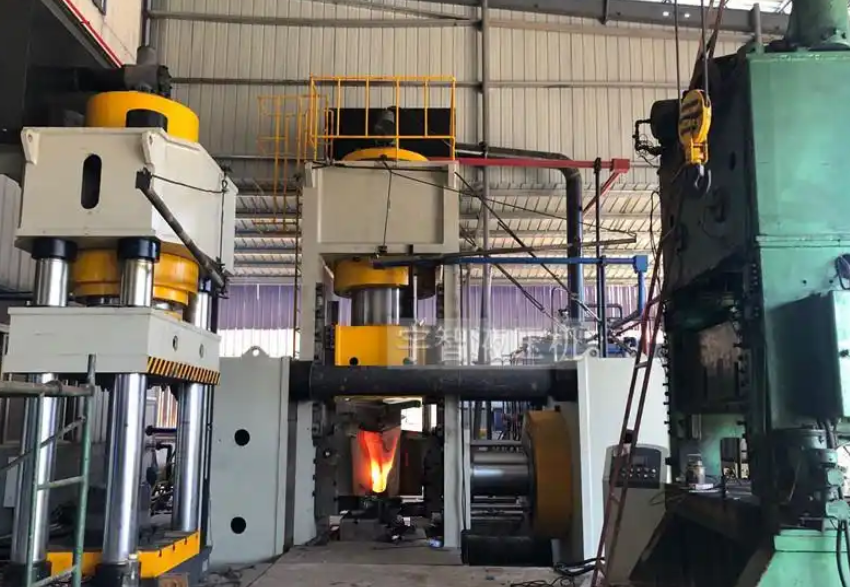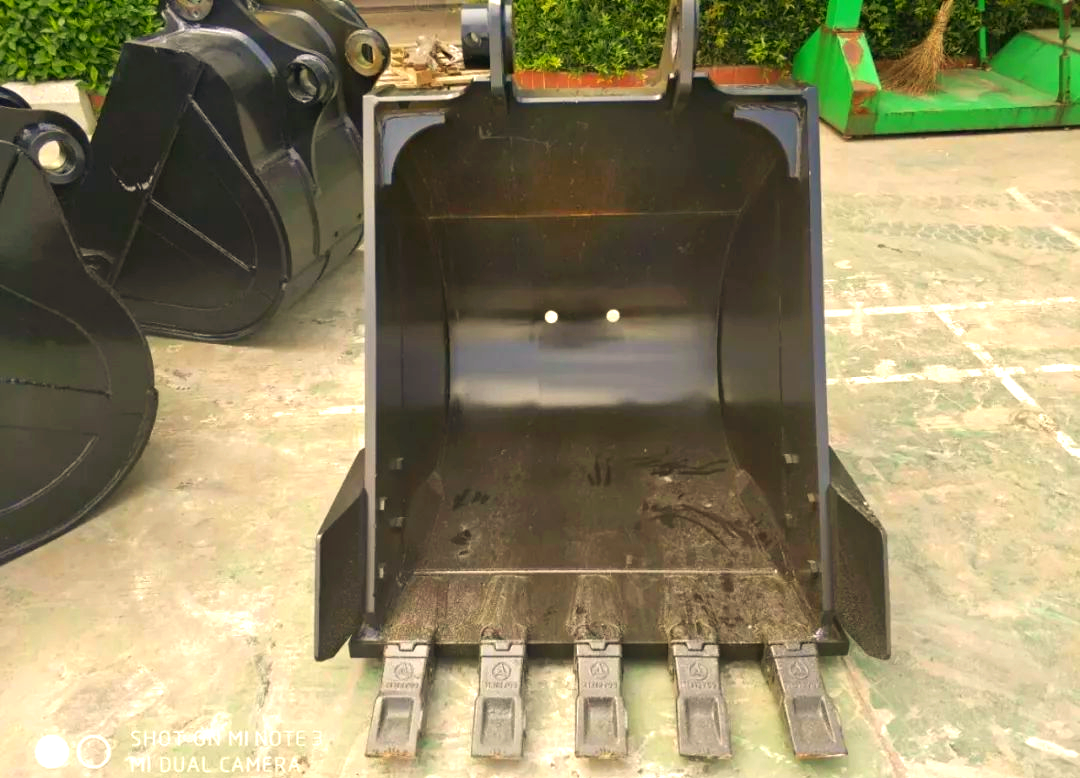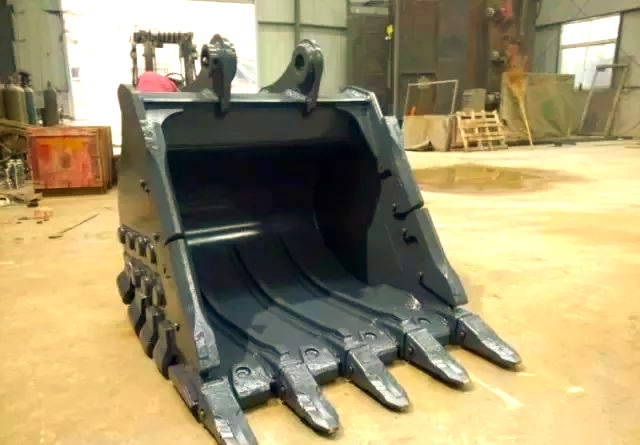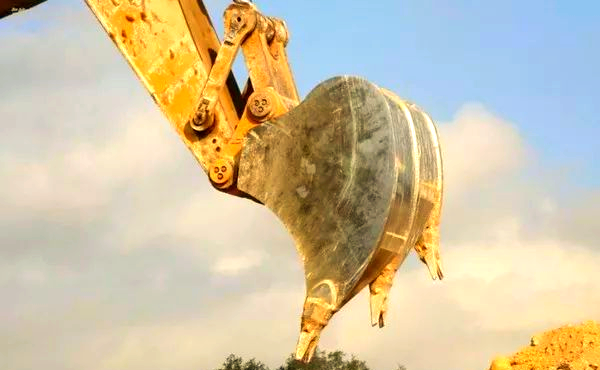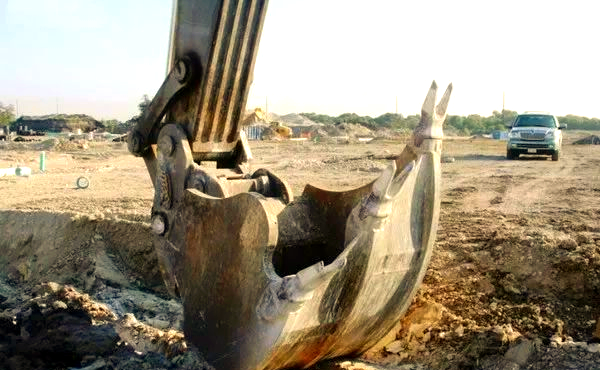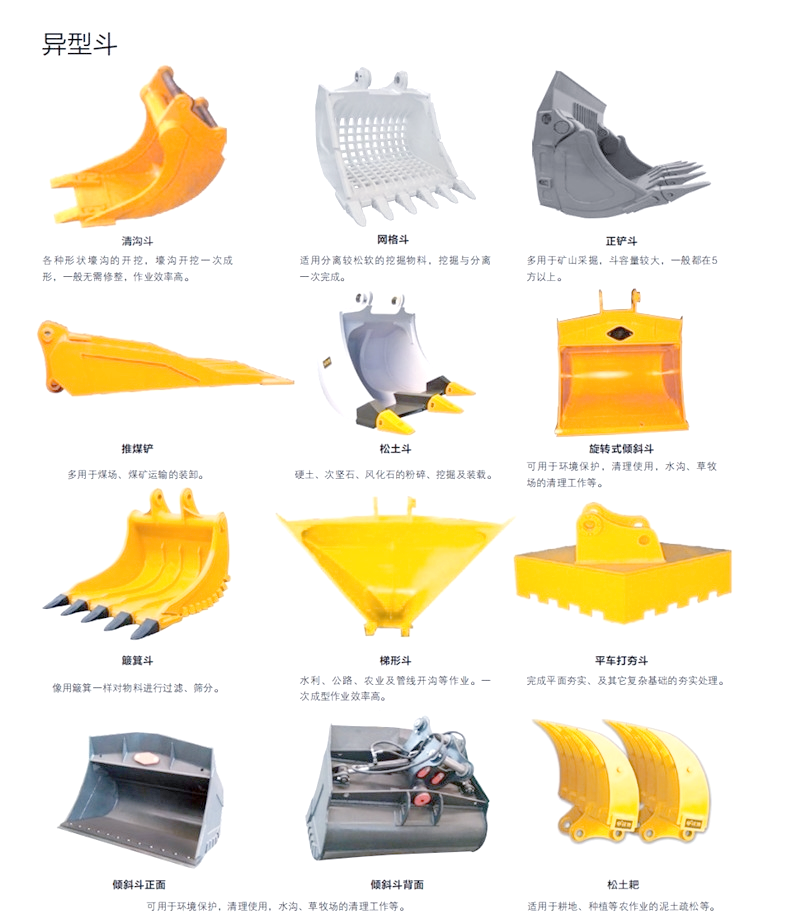Excavator Bucket Types and Functions
Excavator buckets are categorized based on their working methods into backhoe buckets and front shovel buckets, with the backhoe bucket being the most commonly used.
Based on the mechanical action principle, the categories include front shovel, backhoe, clamshell, and dragline.
In terms of material and structural properties, the buckets are divided into standard buckets, reinforced buckets, and mining buckets.
Buckets are also classified by their functional purposes, including earthmoving buckets, rock buckets, loosening buckets, ditch buckets, grizzly buckets, clamshell buckets, cleaning buckets, and tilting buckets, among others.
Types of Excavator Buckets Based on Mechanical Action
Front Shovel Bucket:
The front shovel bucket is hinged at the end of the arm and is driven by a hydraulic cylinder. During operation, the digging force is applied from bottom to top, and the excavation path typically forms an arc. It is suitable for digging sandy soil, gravel, and coal mining above the working surface.
Backhoe Bucket:
The backhoe bucket is connected to the arm with a link and is driven by a hydraulic cylinder. The digging force is applied from top to bottom, with the excavation path forming a circular arc. This bucket is suited for digging soil, sand, gravel, and coal beneath the working surface.
Clamshell Bucket:
Shaped like a shell, the clamshell bucket is driven by a hydraulic cylinder that opens and closes to grab materials. It is commonly used for excavation in building foundation pits, deep pits, and loading loose materials such as coal, sand, clay, and gravel. It is particularly useful for digging or loading in narrow or restricted spaces.
Dragline Bucket:
The dragline bucket is shaped like a scoop, with a tooth seat plate and bucket teeth. During operation, the bucket is thrown onto the excavation surface. The teeth cut into the soil under the bucket's weight, and the bucket is dragged by a winch to continue digging. After filling, the bucket is lifted by a hoist rope and rotated to unload the soil. This type of bucket is suitable for digging below the working surface but has lower excavation precision.
Excavator Bucket Types Based on Material and Structural Properties
Standard Bucket:
Made of high-quality domestic Q345B structural steel, the standard bucket has a larger bucket opening, providing a larger load-bearing area, which results in a higher fill factor. It is suitable for light-duty operations such as digging clay, sand, and gravel loading.
Reinforced Bucket:
The reinforced bucket is built on the standard bucket's framework with high-strength, wear-resistant steel at high-stress and vulnerable parts. The teeth seat plate and side cutting plates are made of high-quality domestic NM360 wear-resistant steel. The thicker materials extend the bucket’s service life. This bucket is suitable for heavy-duty operations like digging hard soil and loading crushed stones and gravel.
Mining Bucket:
The mining bucket has additional reinforcement plates at the bottom, side protection plates, and protective panels. The bottom is designed with a double-arc to increase the clearance and reduce wear. The connection with the arm uses an adjustable gap sleeve mechanism. It is made with Swedish HARDOX ultra-high-strength wear-resistant steel, which extends the product's life by several times. It also uses rock-specific teeth. This bucket is ideal for heavy-duty operations like digging through mixed soil with hard stones, secondary stones, or weathered rocks, as well as loading blasted ores.
Excavator Bucket Types Based on Function and Work Conditions
Earthmoving Bucket:
Typically used for digging clay and loading sand, soil, and gravel in light-duty operations. The large opening and high fill factor improve efficiency.
Rock Bucket:
Used for digging soil mixed with hard stones, secondary stones, or weathered rocks, as well as loading blasted ore. Made of high-strength and wear-resistant steel, it performs well in heavy-duty applications and offers better economic value.
Loosening Bucket:
Used for working on hard soil or frozen ground. These buckets generally feature single or multiple teeth that are sharp enough to break through tough soil.
Ditch Bucket:
Designed for excavation of various shapes of ditches. These buckets allow for one-pass ditch formation, eliminating the need for further adjustments, which improves work efficiency.
Grizzly Bucket:
Ideal for separating loose materials. It combines excavation and separation in one step, widely used in municipal, agricultural, forestry, water conservancy, and earthworks projects.
Clamshell Bucket:
Used for vertical grabbing, typically in foundation pit excavations, deep pits, and for loading loose materials like coal, sand, clay, and gravel. It is especially useful for excavating or loading in narrow spaces or confined areas.
Cleaning and Tilting Buckets:
These buckets are suitable for cleaning and dredging large volumes of dirt and debris from slopes, riverbeds, and ditches. The tilting bucket can adjust its angle via a hydraulic cylinder, greatly improving work efficiency.
Bucket Weight and Its Impact on Machine Performance
The weight of the bucket can affect the machine’s fuel consumption and overall lifespan. A small increase in weight can lead to significant losses. Studies have shown that every 0.5-ton increase in bucket weight can lead to a 10% increase in cycle time and a 15% decrease in annual gross profit. Therefore, it is important to reinforce the most critical parts.
Considerations for Bucket Reinforcement
- Reinforcement at the Tooth Root:
The significant wear of side plates reduces the effective volume of the bucket and affects productivity. Edge cutters help improve material penetration and protect the side plates, so it is necessary to install edge cutters. Reinforcement of the side plates should not be too heavy, as it could impact the overall weight of the bucket. - Bottom Plate Reinforcement:
Reinforcing the bottom plate is crucial. It is recommended that the bottom plate reinforcement be carried out after the new machine’s paint has worn off (approximately one week) for better welding results. Reinforcement should use hard, wear-resistant long plates to protect the overall shape of the bucket and avoid affecting the cutting angle and productivity. Reinforcing ribs should be welded in alignment with the original machine’s ribbing. - Internal Reinforcement:
It is recommended to use hard-faced overlay welding for internal reinforcement, as it offers the best wear resistance and effectiveness, though it is more expensive and time-consuming. Alternatively, some reinforcement ribs may be added, but not too many.
In summary, bucket reinforcement must be effective and secure. The final hard-facing weld can also be used for other parts of the bucket to avoid unnecessary excessive reinforcement, which could negatively affect productivity.
